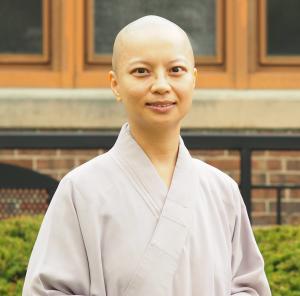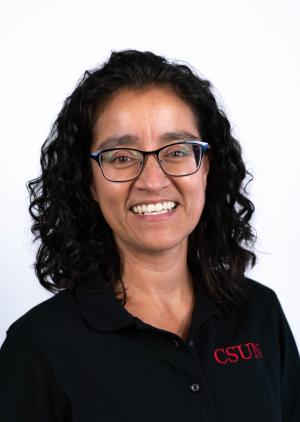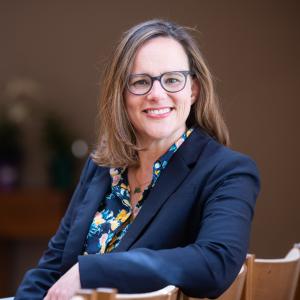Resources
Silhouette Podcast Interview with Emilie Townes

One of my courses is a first-year tutorial designed to fit in with the college-wide objectives to develop new students’ basic academic skills, including writing, critical reading, and oral communication. It also involves individually advising new students to navigate their learning journey until they declare their major field of study. Because the course has multiple goals, it took me a long time to think about an appropriate topic to connect college students’ academic success with their personal lives. I also facilitate students’ embodied learning in their first year. What strategies can I teach them that will enhance their learning progress while adjusting to a new school environment.When designing my course, I found Tammy J. Freiler’s view of being attentive to the entire body as a way of whole-person learning to be helpful. She argues that embodiment is an approach “to construct knowledge through direct engagement in bodily experiences and inhabiting one’s body through a felt sense of being-in-the-world…. It also involves a sense of connectedness and interdependence through the essence of lived experiencing within one’s complete humanness, both body and mind, in perceiving, interacting, and engaging with the surrounding world.”[1] The statement of “complete humanness” inspired my tutorial course topic, “Mindfulness: The Art of Living,” in which I guide students to develop a sense of physical and mental awareness.This is not a meditation course. Instead, the class uses mindfulness as a subject of study. Students study Jeff Wilson’s Mindful America (Oxford, 2014) to build reading, writing, and presentation skills. They also learn how to evaluate the credibility of online resources. While I guide students to take an active role in learning and exploring their academic interests, I encourage them to incorporate mindful practices into their professional performance and everyday life. Teaching the tutorial not only helps me critically reflect upon how to develop a more holistic view of education, but also makes it clear that the traditional approach to teaching mindfulness focuses primarily on the mental aspect, which creates some pitfalls. Although establishing mind-body interaction is the goal, it is easy to neglect the living body as a medium for knowing and connecting with the surrounding world. Several questions and challenges arise, and I have learned at least two noteworthy points about embodied learning. Providing practice-based learning opportunities is not enough. Active engagement is the key to triggering embodied experiences. This notion is too obvious to be overlooked. My first day teaching this class was a bit challenging, in part because it was ironic to guide a discussion about “mindfulness” when students were sleepy. The class started at 8:00 am, a time when young learners felt a lack of energy. Attempting to address this, I added two-minutes of mindful listening (to the natural sounds of birds singing or forest stream), combined with three minutes of relaxing body movement. In theory, this should have been beneficial and meaningful. Some students, however, did not find it useful. Why? The critical element is engaging with the doing and being immersed in the activity. It takes practice to hone one’s mindfulness and cognition. Students cannot gain any constructive effects unless they develop exactly their own whole-body practice, bringing sensory organs and the mind together.Learning space matters, but students may not be mindful of their interactions with the external world. Being at a residential college, all full-time students are required to live on campus, thus there are very few clear boundaries between living and studying spaces. How can I help students develop their bodily awareness in academic environments and beyond? I ask students to write a journal to observe their study habits and in what ways they learn the best. The main concern is whether their bodily activities are related to a learning task in a meaningful way, or not. In addition, I have them pay attention to where the most effective locations that enhance their productivity are, to help students think about how environments affect their cognitive process. Some students report locations where they feel less anxious while doing homework, including the Spencer Grill (a café), the atrium at the Human and Social Studies Center, and outdoors. None of them mention their dorm rooms. Students’ reflections are meaningful, as they develop their bodily awareness on campus, acknowledge the body as a basis for their being in the world, and create a personal connection with their surroundings. Teaching first-year students about mindfulness allows me to reflect that learning involves embodied cognition. Although most agree that mindfulness is a practical approach to dealing with day-to-day issues, not everyone values the importance of being attentive to the body. They tend to take their physical presence for granted, and aren’t aware of body experiences as a way of knowing. Thus, it is my responsibility to guide students to develop cognitive awareness, which can subsequently help them appreciate mind-body integration as a powerful tool to enhance productive learning. [1] Tammy J. Freiler, “Learning Through the Body.” New Directions for Adult and Continuing Education 119, (2008): 40, DOI: 10.1002/ace.304.
Interview with Carolyn Medine
Interview with Katherine Turpin.

I was asked for pictures of me while teaching in the classroom. An organization I’m part of wanted them for one of their platforms and I obliged. I asked a student to use their phone to take pictures of me during one of our class sessions. I asked them to do it discreetly so the pictures could be as candid as possible. And boy were they candid—and revealing! I was rolling laughing as I saw myself in all kinds of animated postures: down on one knee, face looking upward, arms outstretched toward the sky; all manner of facial expressions and creative hand gestures; nutty drawings of giant circles and spirals on the chalkboard as I tried to explain who-knows-what concept. It was a surprise to me that my teaching style was so animated and a bit dramatic. And while it amused me to see this about myself, it did not make me self-conscious, for even though I had not realized this about myself, my students surely had known me this way the whole time. I got to see what my teaching looked like a little better and know that while there is no single way to teach, I surely had mine. The larger point, of course, is that there is no blueprint to how we embody our teaching, and the more we understand this and understand ourselves, the better we can move into our own. I had received an earlier lesson on embodiment the very first time I presented a paper at the annual meeting of the American Academy of Religion (AAR). I hated every minute of my first paper presentation: I hated the podium—how much it blocked my sense of connection with the listeners and made me feel like I could not see everyone clearly. I hated the microphone because it meant I couldn’t move about and I had to stand on my tiptoes to try and keep it at the right level. I hated reading the paper because it meant I was the only one speaking that whole time. It was a stressful and miserable experience. The following year, then, when I was to take part in a commemorative panel scheduled in one of the very large presentation rooms at AAR, I knew I had to find a way to change my experience of presenting. Through a friend, I received acting coach tips to help me feel more comfortable and confident about presenting. The advice in a nutshell was to experiment and play with the embodiment of the activity: practice being at the podium, around it, in front of it; explore ways to change my spatial relationship with the listeners, the paper, the microphone. Play with time, pauses, moments of possible interactions with the listeners, even if not explicitly verbal. She told me to listen to what my body was telling me through its discomfort—what exactly was not working? —and to explore ways to address and attend to the cause of the experience. I should accept that presenting in the traditional way did not work for me and explore and play with various adjustments and shifts to discover the approach that did work for me. Effectively, she released me from the idea that there was a single blueprint for conference paper presentations and encouraged me to bring myself, mind and body, to discover my own. In my last post I wrote that “we teach humans, not subjects,” and argued that in our teaching it is important to attend to the humans before us first and foremost. It is likewise important to attend to ourselves, to who we are in the wholeness of our mind and body, and to allow ourselves to feel and sink into the embodiment of the teaching relationship. Teaching is relational as much as it is embodied. And it takes some experimenting to find one’s grounding within them both. But before receiving the tips from the acting coach, I received an invaluable tip from a student that has remained with me since my first week as a professor. The Faculty Development team at my university invited students to join the new faculty for lunch and an informal Q & A during the new faculty orientation event. I asked the student sitting at my table, “If you could give one piece of advice to new faculty, what would that be?” He said, “Let us see you as human, sometimes. Be ok showing us your ‘non-professor human side’; it helps us relate to you better.” I always remember that tip—it reminds me that it is okay to bring my peculiar, embodied self to the relational activity of teaching and to give myself permission to sink into it, even with its flair and dramatic gestures. What’s yours?
Interview with Evelyn Parker

It was a spectacular morning on Emory’s verdant quad. The early October air was just offering the hint of crispness that announced the imminent arrival of fall. The grass, roped off for re-seeding (a detail some students thought revealed loving care for the soil and others thought revealed a desire to control a manicured landscape), shimmered a dewy electric green. The oak trees’ leaves were beginning to flaunt their autumn gold, offset by an expanse of sky the color of a robin’s egg. But then, I noticed two students were standing off to the side of the rest of the class, whispering to each other, smiling, and almost giggling. All my self-preservation alarm bells hard-earned in junior high started going off. What are they laughing at? Is it me? Am I doing or saying something stupid? It was the “Religious Education and Our Ecological Context” class, and we’d come out to the quad on an October morning to discuss and try to practice Sallie McFague’s use (which she borrows from Marilyn Frye) of the concepts of the “loving eye” and the “arrogant eye” when encountering nature.[1] When beholding nature with an arrogant eye, we look upon it as an object, something separate from ourselves for our use and convenience. When beholding nature with a loving eye, we acknowledge its mystery and relationship to us, appreciating it on its own terms. The students were divided into two groups, each of which assumed the point of view of the arrogant eye or the loving eye and asked to make notes of what they saw or encountered in the quad from that point of view. Some students bounded off in pairs or trios, chatting and pointing out what they saw to their classmates, while others slowly wandered off quietly by themselves, pens and notebooks in hand. A couple of students lingered near me, asking a question about an upcoming assignment, perhaps not entirely comfortable with this task of just being in their bodies outdoors. I often incorporate such embodied and contemplative learning experiences, particularly in this class. In fact, the students also were asked to choose a location, near where they live, to observe for five minutes daily. They were invited to marshal all their senses to make note of all the changes in that place as the semester slid from late summer into fall, and then winter. A few weeks earlier, we visited an art installation by Charmaine Minniefield at Emory’s Carlos Museum, Indigo Prayers: A Creation Story. In that work, Minniefield powerfully uses pigments indigenous to Gambia, where her ancestral roots are found, to visually represent the “ring shout,” a dance of prayer and resistance. In these seven very large paintings, installed in such a way that they move slightly as one walks past, the artist’s own body is represented. The paintings tell an embodied story of the relationship between the self and place (and displacement), mirroring a theme for our class. All of this is to say that in this class, which considers the spiritual and moral relationship of the self (and the community) to particular places and to the “more-than-human world,”[2] I have intentionally built in embodied pedagogies to open up paths of knowing perhaps not available in more didactic or even discursive classroom activities. I made this decision on sure theoretical and pedagogical footing: Donna Haraway and Lorraine Code both argue for a more expanded epistemological framework, appreciating the role that embodied and emotional experience play in the production of knowledge.[3] And yet, as we were gathering back to talk about the experience, I was distracted by the two students standing very near me who seemed to be having a laugh at my expense. I immediately began to second guess my choice to bring the class outdoors. My inner voice began shouting at me: “This is graduate school for God’s sake! Get serious!” (I suspect that my inner voice comes from the same place as Stephanie Crumpton’s, also featured in this blog series: “Even worse, I hear my own voice telling me, ‘You’re dumbing it and yourself down. Folks [including yourself] need to step it up.’”) I didn’t want to put the students on the spot, but they made eye contact with me as I opened up the discussion. I paused, and one of them said, “We were just saying how much we like it that you take us on ‘field trips.’” They were happy. Now, I can’t say that knowing this fact erased my self-doubt. Indeed, there’s some small part of me that still believes seriousness and joy are somehow in tension with each other, and learning should be serious. As the conversation unfolded, however, a tapestry was woven that incorporated all the students had beheld on the quad, and the ways in which McFague’s categories accounted for (or didn’t) the ways in which we were relating to the more-than-human world in this moment. I revealed more of my pedagogical rationale for being out there, the principle of embodied learning as a pathway to ecological knowing, though we’d discussed that principle before in the ordinary classroom. As we walked back to the building, the students were animated, talking about the ways in which they might incorporate similar practices in their field sites or other settings. And we were happy. [1] Sallie McFague, Super, Natural Christians: How We Should Love Nature (Minneapolis, MN: Augsburg Fortress, 1997). [2] Abram uses this phrase to appreciate the animacy of the natural world, and to avoid objectifying dualism. David Abram, The Spell of the Sensuous: Perception and Language in a More-Than-Human-World (New York, NY: Pantheon Books, 1996). [3] Donna Haraway, “Situated Knowledges: The Science Question in Feminism and the Privilege of Partial Perspective,” Feminist Studies 14, no. 3 (1988): 575–599; Lorraine Code, Ecological Thinking: The Politics of Epistemic Location (New York, NY: Oxford University Press, 2006).
To whom are you obligated when you complete your degree? If education is for the public good – then what does it mean that public education promotes and forms individualism? What is the purpose and aim of public education, of higher education? What if the policing of teaching is detrimental to the thriving of a democratic republic? What would it mean to promote communal values in classrooms bound to shaping individualistic mindsets?
Wabash Center Staff Contact
Sarah Farmer, Ph.D
Associate Director
Wabash Center
farmers@wabash.edu